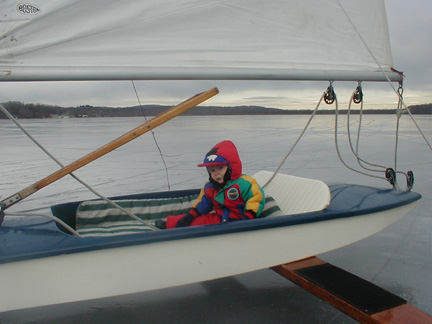|
Copyright John A. Sperr HRIYC.ORG June 4, 2012
Iceboat Launch Site Maps & Directory for the Eastern US
|
|
Growing Organic Wild Blueberries in Maine Wild blueberries are small woody plants that grow from rhizomes living in the top 6 to 8 inches of soil. They are acid loving plants with low nitrogen requirements which makes them ideal for the thin glacial soils of Downeast Maine. The crop totaled 83 million pounds in 2011 and brought and average of $0.85 per pound to growers. Certified organic growers can often realize three or four times that price. In commercial cultivation, the fields are managed in a two year cycle. In the "crop year", the plants blossom in late May and, with the aid of imported honeybees, are quickly pollinated and set fruit. Two months later, in late July or early August, the fruit ripens and is ready for harvest. Fall or early winter brings the first heavy freeze and the dormant plants begin the "prune year". When conditions allow in late winter or early spring, the field is burned with added straw, the existing vegetation, or oil fired torches. The field can also be mowed flush to the surface of the ground with a flail mower. Burning kills weeds, insects, and disease organisms as well as the small blueberry stems that bore the fruit the previous summer. When growth resumes in April, the rhizomes push up new shoots from below the surface that generate new stems and buds that will mature and become fruitful the following year. In the summer of 2011 we began recovering a six acre field that has not been managed for the past 12 - 15 years. The first step was cutting the large brush and trees from over an acre with chain saw and clippers. It is slow and tiring work as anything that is not cut flush to the ground becomes both a hazard to people and equipment and will quickly regenerate. We laid out the perimeter and then slowly and methodically worked our way through the area piling the big stuff on the exposed areas of bedrock for a winter bonfire. The deep grass and weeds hide rocks and boulders strewn about by the retreat of the glaciers of the last ice age and small swales and kettles pockmark the surface -- ready to twist your ankle or cause you to stumble and fall.
|
This spring, we burned the field. The fire was quite hot with all the residual weeds and grass, so the regeneration has been slow even with the early warm weather we have had. Burning an unmanaged field exposes the next round of work -- all the stumps that did not get cut off close enough to the ground, the wax berry plants that did not burn up, and the ground hugging evergreens that were missed on the first pass. We also spread sulfur prills to reduce the pH of the soil down towards a value of 4.3 -- that makes it a more favorable growth environment for the wild blueberry plants and more hostile to the grass, weeds, and trees.
Recent Photo Albums |
Links to Field Reports of Ice Conditions
|
Disclaimer HRIYC.ORG is neither the official website, nor am I the webmaster, of the Hudson River Ice Yacht Club. I am a long standing member of the Club -- during the sailing season, I frequently post photographs and information on this, my own personal website, about current iceboating activity in the Hudson Valley and beyond. I am the sole person responsible for the presentation of content and the opinions expressed herein. Interesting photographic contributions are welcome and appreciated -- I spend most of my time on the ice skippering and far too often fail to capture the best images the day has to offer. JAS |
ŠJohn A. Sperr MMXII


